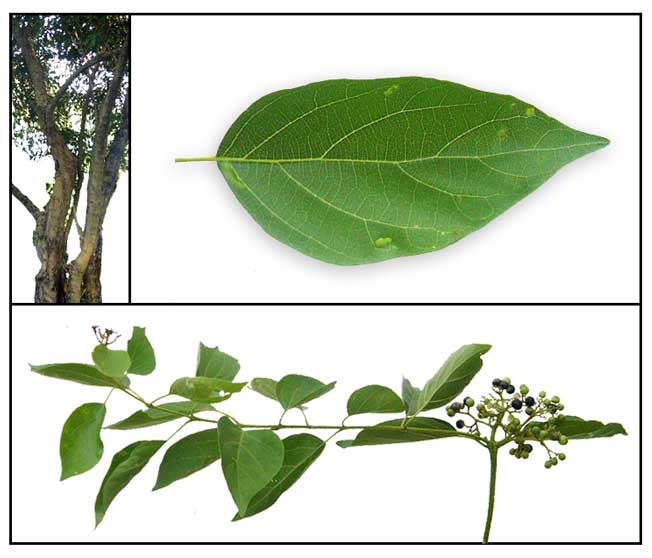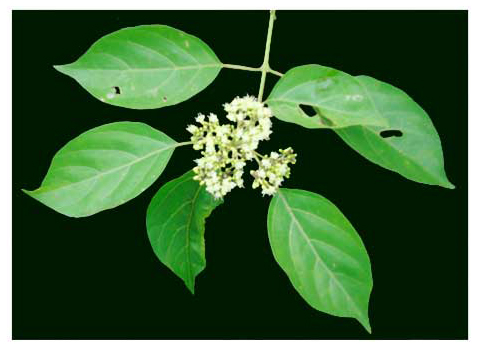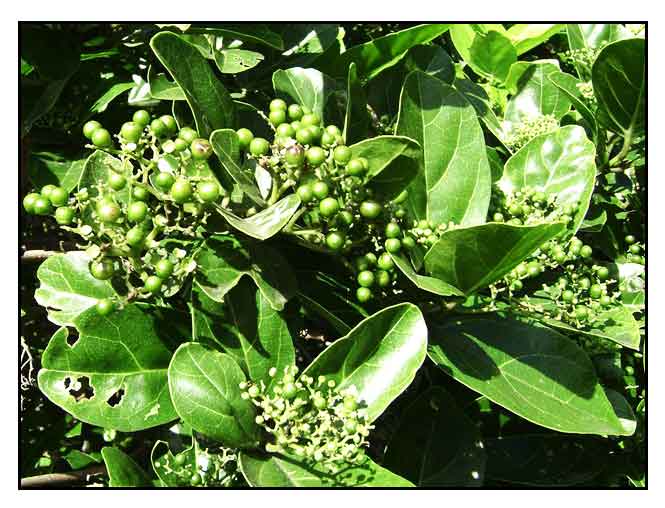
Botany
Alagau-gubat is a shrub or small tree
reaching a height of 10 meters, slightly hairy to nearly smooth. Leaves are
elliptic-ovate to oblong-ovate, 6 to 10 centimeters long, 3 to 6 centimeters wide, pointed
at the tip and pointed or rounded at the base. Flowers are small,
greenish or greenish white, numerous, borne on terminal inflorescences
(cymes), and up to 5 centimeters long and 6 centimeters wide. Calyx is green, equally
4-toothed and 1 to 1.5 centimeters long. Corolla is 4 millimeters long and hairy inside.
Stamens are white and exserted. Fruit is rounded, fleshy, dark purple, 4 to 5 millimeters
long.
 Distribution Distribution
- Found In secondary forests
at low altitudes in Cagayan, Ilocos Sur, Isabela, La Union, Pangasinan, Zambales, Nueva Ecija, Tarlac, Bulacan, Bataan, Rizal, Batangas, Laguna, Quezon, and Camarines Provinces in Luzon.
- Indigenous to East Africa, India, Bangladesh, Japan, Chine, Taiwan, Papua New Guinea, Australia, Polynesia and Melanesia.
Properties
- Leaves have a rank odor when crushed.
- Roots are laxative and stomachic.
-
Used as cardiotonic, adaptogenic, antibiotic, anticoagulant, stomachic, carminative, hepatoprotective, galactagogue, laxative.
- Premnine and ganiarine have sympathomimetic actions.
- Studies have suggested antibacterial, anti-diabetic, immunomodulatory, antioxidant, anti-inflammatory, analgesic, cytotoxic, hepatoprotective, antiparasitic, anti-leishmanial, cardioprotective, anti-arthritic, anticancer, neuropharmacologic, anti-anemic, anti-atherosclerotic properties.
 Constituents Constituents
- Stem bark contains three alkaloids: premnine, ganiarine, ganikarine.
- Phytochemical screening yielded flavonoids, steroids, alkaloids, glycosides and phenolic compounds.
- Study of various extracts of root powder yielded alkaloids, carbohydrates, amino acids, steroids, flavonoids, glycosides, tannins, and phenolic compounds. (20)
- GC-MS study for volatile constituents of leaves and roots yielded 29 compounds. Major compounds were 1H- Cycloprop[e]azulen-7-ol, decahydro-1,1,7-trimethyl-4-methylene-, [1ar-(1aà,4aà,7á,7aá,7bà)]- (2.98 %), 2- Furancarboxaldehyde, 5-(hydroxymethyl)- (2.44 %), 2-Hydroxy-3-methylbenzaldehyde (6.39 %), 2s,6s-2,6,8,8- Tetramethyltricyclo[5.2.2.0(1,6)]undecan-2-ol (6.35 %), Benzofuran, 2,3-dihydro- (29.94 %), Glycerin (1.14 %), n-Hexadecanoic acid (13.94%), 2-Propenoic acid, 3-(4-methoxyphenyl)- (13.84 %). (28)
- Preliminary phytochemical screening of methanol bark extract yielded alkaloids, flavonoids, phenols, steroids, and glycosides. (see study below)
(31)
- Study for essential oil of air-dried eaves yielded 29 compounds representing 95.73 % of total oil from leaves, with a complex mixture of oxygenated mono-sesquiterpene hydrocarbons. Major compounds were phytol (27.25%), α-humulene (14.21%), spathulenol (12.12%), 1-octen-3-ol (8.21%), eugenol (6.69%), phenylethyl alcohol (5.81%), and caryophyllene oxide (2.61%). (see study below) (33)
- Phytochemical screening of hydroalcoholic extract of root bark yielded alkaloids, triterpenoids, coumarins, steroids, tannins, saponins, flavonoids, quinones, flavanones, anthocyanins, phenols, carbohydrates, glycosides, amino acids, and furan, with absence of proteins and anthoquinones.
(35)
- Study of aerial parts isolated three glycosides: acteoside (1), premnaodoroside A (2), and premnaodoroside B (3).
(40)
Parts used
Leaves, bark, roots.
Uses
Edibility
- Leaves cooked and eaten as vegetable.
- Leaves used as medicinal tea.
- Seeds and ripe fruits reportedly edible.
Folkloric
- Leaves sometimes used
as a "ñgañga" component, substitute for Piper betle with seeds
of Areca catechu.
- Leaves used for variety of stomach ailments.
- Root bark used for fevers, liver complaints, rheumatism, neuralgia.
- In Myanmar, roots and stem bark used as
laxative, carminative and stomachic. Decoction of whole plant used for
fevers, rheumatism and neuralgia. source
- In Ayurveda,
roots are incorporated in many formulations.
- Leaves eaten to increase breast milk production.
- P. integrifolia is an important constituent of the herbal formulation of ten roots known as Dasamula, widely used in the Indian system of medicine.
(22)
-
- In the Polynesian Islands, used to treat leucorrhea, genital disease, cancer sores, bad breath, and white tongue. (23)
Others
- Nga-nga: Leaves are reportedly used as substitute for Piper betle for chewing with seeds of Areca catechu.
- Dye: Roots yield a dye. Root bark yields a yellowish-brown powder that produces a yellow-brown tincture with alcohol. (26)
- Wood: Used for making simple instruments: handles, oars, etc.
- Bark: Used for rope or cordage.
Studies
• Antibacterial / Root Bark: The alcoholic extract of the
root bark showed good antibacterial activity against gram-positive organisms
in a preliminary screening. (1)
• Immunomodulatory
Activity: The roots of both plants of C. phlomidis and
Premna integrifolia are incorporated in many valued Ayurvedic formulations.
In a study evaluating the roots for immunomodulatory potential, both roots
showed immunoprophylactic effect with C phlomidis showing higher response to specific immune activity. In no specific immune activity, both roots showed equal response.
(2)
• The effect of Premna integrifolia Linn.
(Verbenaceae) on blood glucose in streptozotocin induced type 1 and
type 2 diabetic rats. (3)
• Hypoglycemic activity: In a study of 30 hypoglycemic plants from indigenous folk medicines, Premna integrifolia was one of 24 samples (14th) that showed significant blood glucose lowering activity. (4)
• Premnazole / Anti-Inflammatory Activity: Premnazole, an isoxazole alkaloid from Premna integrifolia and Gmelina arborea exhibited significant anti-inflammatory activity in rats, comparable to that of phenylbutazone.
• Cardiac Stimulant Activity: PS contains alkaloids and iridoid glycoside. Study suggests that the ethanol extract produced a cardiotonic effect and the aqueous extract produced a ß-adrenergic effect. (6)
• Cardioprotective: Study confirmed the cardioprotective effect of an ethanol extract of Premna serratifolia on isoproterenol-induced myocardial infarction in rats. The effect was attributed to phytoconstituents, viz., iridoid glycosides, alkaloids, flavonoids, and phenolic compounds. (11)
• Hepatoprotective / Cytotoxic Activity: Study showed the alcoholic extract with significant hepatoprotective activity evidenced by decrease of serum enzymes, bilirubin and lipid peroxidation, comparable to drug silymarin. It also exhibited significant in-vitro cytotoxic activity. Results showed the alcoholic extract not only as an effective hepatoprotective agent, but with also significant antitumor activity. (8)
• Antiparasitic Activity / Anti-Leishmanial: In a study of 18 medicinal plants in New Caledonia evaluated in vitro against several parasites, Scaveola balansae and Premna serratifolia were the most active against Leishmania donovani. P. serratifolia showed IC50s between 0.5 and 5 µg/mL. (9)
• Anti-Arthritic: Study of ethanol extract of wood of Premna serratifolia exhibited significant anti-arthritic activity against adjuvant-induced arthritis. The activity was attributed to the presence of phytoconstituents such as iridoid glycosides, alkaloids, phenolic compounds and flavonoids. (10)
• Antioxidant: Study showed effective free radical scavenging activity, reducing power, and nitric oxide scavenging activity. The antioxidant properties were concentration dependent, with the ethanol extract showing the highest activity. Preliminary screening yielded flavonoids, steroids, alkaloids, glycosides and phenolic compounds. (12)
• Anti-Obesity: Study evaluated the anti-obesity activity of a chloroform extract of P. integrifolia in Swiss albino mice fed with cafeteria diet. Results showed dose-dependent anti-obesity activity. (14) Study evaluated the effect of aqueous enriched fraction of P. integrifolia against cafeteria diet induced obesity in Swiss albino mice. Results showed significant decrease in body weight, BMI, food consumption, and levels of serum glucose, triglycerides, total cholesterol, LDL, and VLDL, with significant increase in HDL in mice treated with the enriched fraction and simvastatin. (29)
• Anti-Inflammatory / Antioxidant: Study evaluated a methanolic extract for anti-inflammatory and antioxidant activities. Results significantly demonstrated anti-inflammatory activity of P. integrifolia roots in various models through antihistaminic, antikinin, COX-inhibitory and antioxidant action. (15)
• Silver Nanoparticles / Anti-Cancer Activity / Leaves: Study reports the biosynthesis of silver nanoparticles using an ethanolic leaf powder extract of Premna serratifolia L. and its anticancer activity in carbon tetrachloride-induced liver cancer in Swiss albino mice. The silver NP were effective in treating liver cancer in mice when compared with P. serratifolia leaf extract with isoleucine. (17)
• Anti-Inflammatory / Analgesic / Neuropharmacologic / / Bark: Study evaluated methanolic extract of bark in rats to evaluate for neuropharmacologic, analgesic and anti-inflammatory activities. Results showed statistically significant decrease in locomotor activity, significant and dose dependent reduced writhing reflex in acetic acid-induced writhing test and inhibition in carrageenan induced anti-inflammatory activity. (18)
• Antioxidant / Beneficial Effects on Human WBC and Erythrocytes against H2O2 Induced Oxidative Damage: Study showed root extracts of P. integrifolia possess beneficial effect on human leucocytes and erythrocytes against H2O2 induced oxidative damage. Effect was attributed to flavonoid and phenol contents. (19)
• Antioxidant / Tumor Cell Suppression: Study showed a methanolic extract of P. serratifolia L. to have free radical scavenging activity against superoxide radical, NO radical, OH radical DPPH radical, ABTS radical and inhibition of lipid peroxidation. Study also showed cytotoxic activity against MCF7, HepG2 and A549 cells. (20)
• Silver Nanoparticles / Anticancer / Leaves: Study evaluated the anticancer activity of biosynthesized silver nanoparticles (AgNPs) using an ethanolic leaf extract against carbon tetrachloride induced liver cancer in Swiss albino mice.
• Antiulcer / Gastroprotective / Leaves: Study reports on the gastroprotective activity of P. serratifolia on aspirin-induced ulcer rats using parameters of lesion index, total and free acidity, and percentage of ulceration. Results showed significant antiulcer and antisecretory activities in doses of 200 and 400 mg/kbw. (23)
• Cytotoxicity of Isolated Constituents / MCF-7 and HT-29 Cell Lines / Leaves: Study evaluated the cytotoxicity of phytoconstituents isolated from the n-hexane soluble fraction of P. serratifolia leaf extract. Column chromatography yielded 5 sub-fractions (PS-01-PS-05), which were all triterpenoids in nature. Two isolates were found to be active, and one compound (sub-fraction PS-02) showed significant cytotoxicity against MCF-7 (breast cancer) and HT-29 (adenocarcinoma) cell lines with LC50s of 100.0 and 99.9 µg/mL, respectively. (24)
• Antioxidant / Anti-Inflammatory / Flowers: Study evaluated a methanolic extract of flowers for antioxidant and in vitro anti-inflammatory activity. Anti-inflammatory activity was evaluated by prevention of hypotonicity induced HRBC membrane lysis. Results showed potent antioxidant and anti-inflammatory activity attributed to the presence of flavonoids. (25)
• Antioxidant / Benefits Against H2O2 Induced Oxidative Damage / Roots: Study evaluated the effects of extracts of P. integrifolia roots on human leucocytes ad erythrocytes against hydrogen peroxide (H2O2) induced oxidative damage. Results showed decrease in CAT, SOD, GPx and increase of GSH and LPO levels. Effects were attributed to flavonoid and phenol contents in the plant. (27)
• New Tetrahydrofuran Lignan / Anti-Melanin Deposition Activity: Study of CHCl3 extract of P. serratifolia wood isolated a new tetrahydrofuran type lignan, 7,9-dihydroxydolichanthin B (1), together with two known triterpenoids, oleanonic acid (2) and (2a,3a)-dihydroxyolean-12-1n-28-oicacid (3). Compounds 1-3 had anti-melanin deposition activities against IBMX and a-MSH induced B16-F10 mouse melanoma cell line with IC50s of 18.4, 17.7, and 11.2 µM, respectively. Compound 2 exhibited cytotoxicity at concentrations above 50 µM. (30)
• Antiulcer / Cytoprotective / Aspirin-Induced Models / Bark: Study evaluated the antiulcer activity of methanolic bark extract pf P. serratifolia against aspirin-induced models of male wistar rats. In aspirin-induced pylorus ligated model, the bark extract showed significant decrease in the volume of gastric acid, free and total acidity, ulcer score, ulcer index, and increase in pH of gastric juice compared to toxicant control group. (31)
• Antidiabetic / Antioxidant / Leaves: Study evaluated the α-glucosidase inhibitory and antioxidant activities of infusion and decoction of P. serratifolia leaves. The total phenolic content of the decoction was higher than the infusion. Both infusion and decoction exhibited strong α-glucosidase inhibition with IC50s of 4.27 and 0.046 µg GAE/ml, respectively. DPPH scavenging activity showed IC50s of 6.82 and 7.28 µg/ GAE/ml for infusion and decoction, respectively. (32)
• Composition / Free Radical Scavenging Effect / Essential Oil / Leaves: Study evaluated the chemical composition and antioxidant efficacy of essential oil of air-dried leaves. Major compounds were phytol (27.25%), a-humulene (14.21%), spathulenol (12.12%), 1-octen-3-ol (8.21%), eugenol (6.69%), phenylethyl alcohol (5.81%), and caryophyllene oxide (2.61%). The EO showed strongest free radical scavenging activity with an IC50 of 24.19 µg/ml. The methanol and ethyl acetate extracts showed little activity with IC50 of 90,42 µg/ml compared to L-ascorbic acid with IC50 of 15.13 µg/ml. (33)
• Analgesic / Antibacterial / Leaves: Study evaluated the ethanolic extract of leaves for analgesic and antibacterial activity. In analgesic activity, the extract showed 52.17% (p<0.01) acetic acid induced writhing inhibition in mice at dose of 500 mg/kbw, comparable to diclofenac. The extract showed significant antibacterial activity against both gram positive and gram negative bacteria. (34)
• Cytotoxicity / Phenolic Content: Study evaluated six selected Indian medicinal plants for cytotoxicity and polyphenolic compound content. Fractions 1, 2, and 3 of P. serratifolia showed significant cytotoxicity (LC50<100ppm) with LC50 values of 7.61, 4.01, and 10.91. Premna serratifolia also showed significantly higher total phenolic content (TPC) 39.11 mg gallic acid equivalent (GAE/g) compared to the other plants. (36)
• Hematological Effects / Anti-Anemic / Leaves: Study evaluated an ethanolic leaf extract for micronutrients (iron, phosphorus, calcium, ascorbic acid) and effect on hematological parameters (hemoglobin, RBC count, mean corpuscular Hb) of anemic rats. Results showed the leaf extract had higher impact on hematological parameters when compared with standard drug ferrous fumarate. The higher incorporation of P. serratifolia leaf powder helped increase the nutrient content in formulated snacks. (37)
• Neuropharmacologic / Analgesic / Anti-Inflammatory / Bark: Study evaluated methanolic extract of bark for neuropharmacologic, anti-inflammatory and analgesic activity. Results showed statistically significant (p<0.05) decrease in locomotor activity by open field and hole cross test, significant (p<0.05) and dose dependent reduction of writhing reflex in acetic acid induced writhing test and decreased licking response in formalin induced inflammatory pain. The extract also showed anti-inflammatory activity with 71.16% inhibition in carrageenan induced inflammatory model. (38)
• Anti-Atherosclerotic / Root Bark: Study evaluated the anti-atherosclerotic activity of hydroalcoholic extract of root bark of P. integrifolia in high fat diet induced atherosclerosis in Wistar rats. Results showed significant and dose dependent anti-atherosclerotic activity in terms of reduction in lipids and lipoprotein profile, atherogenic index, HMG-CoA reductase activity, marker enzymes (LDH, CPK, AST, ALT, ALP). Antiatherosclerotic activity was attributed to the modulatory activity on the metabolic pathway of lipid. The results contribute to the validation of the traditional use of Agnimantha in high fat diet induced atherosclerosis in rats. (38)
Availability
Wild-crafted. |



 Distribution
Distribution


